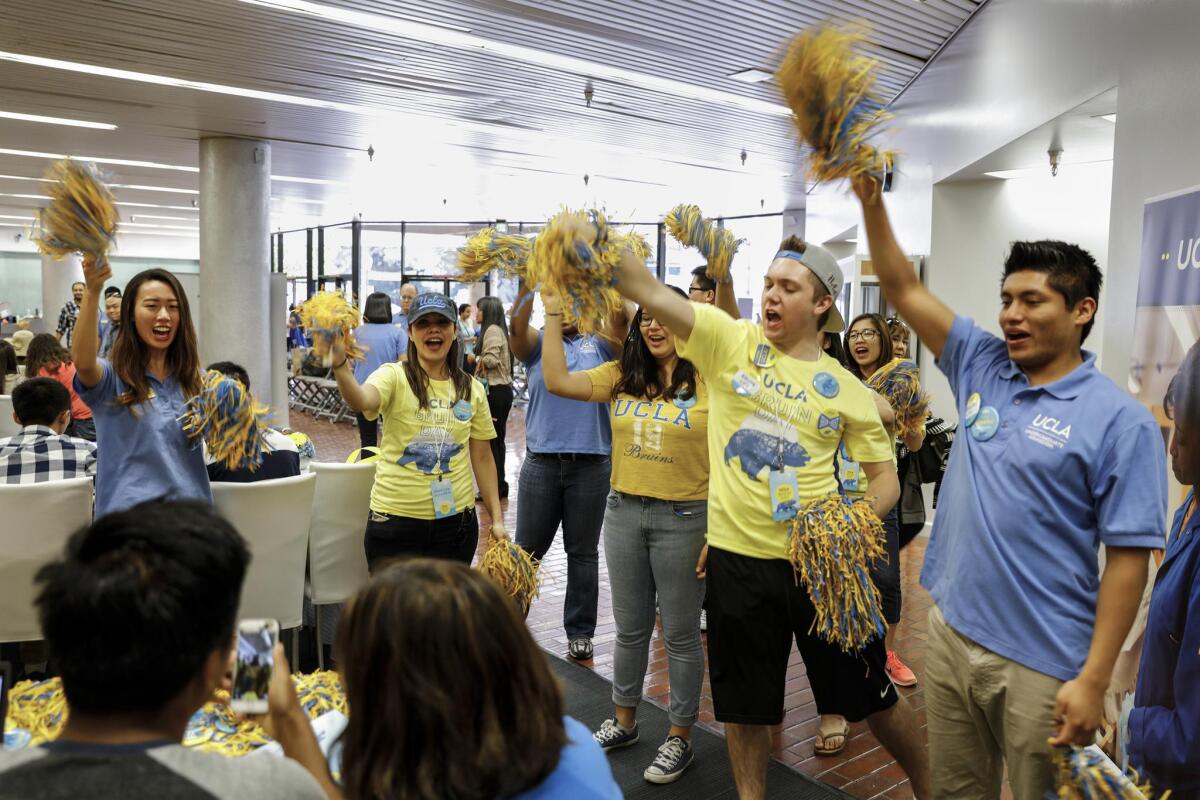UC and CSU extend May 1 deadline to accept admission offers for fall 2024, citing FAFSA delays

The University of California and California State University announced Wednesday they are extending the May 1 deadline for students to accept their admission offers for fall 2024, citing delays applicants are facing in completing a new federal financial aid form.
The extension affects tens of thousands of California students who will be accepted to UC and CSU, largely beginning in March. A May 15 deadline will apply to first-year students at all nine undergraduate UC campuses; CSU’s deadline is “no earlier” than May 15 for all 23 of its campuses.
A new version of the form, known as the Free Application for Federal Student Aid, or FAFSA, was unveiled late last year with the promise that it would be simpler to complete and would increase the amount of financial aid available for many students. The form is used by colleges to determine financial need and craft an aid offer.
But significant delays in the federal government’s release of the new form, along with numerous glitches in using it, have created havoc at many high schools, which are reporting a dramatic decline in the number ofstudents who have so far successfully completed the form.
“It’s a disaster,” said Lynda McGee, a counselor at Downtown Magnets High School near the Los Angeles civic center. “The students who will be most hurt are our low-income and first-generation students.”
At Downtown Magnets, which often wins honors from L.A. Unified for high rates of FAFSA completion, only one-third of seniors had completed the form as of Jan. 26 compared with the number on that date last year, according to federal data.
Without college financial aid offers, which are typically sent out with an acceptance letter, students and families can’t evaluate which campus is most affordable.
Los Angeles Unified schools Supt. Alberto Carvalho said the delays and glitches in the process are especially harmful for students in his system: About 80% of students qualify for free or reduced-price meals at school. Many students start off as English learners; many parents either don’t speak English or have limited education or both.
“We have such a disproportionate number of students who absolutely depend on this type of financial assistance for college support,” Carvalho said. “This really has created a bottleneck and a significant reduction in the number of FAFSA submissions — by as much as 50%. And if very specific actions are not taken quickly that issue may not necessarily be remediated.”
He would like all colleges to follow the lead of those that have extended deadlines for students. An extension of one or two months might be necessary, he said.
“Not only necessary, but morally required,” Carvalho added.
UC officials pledged to ensure that all students, especially those from underserved communities, will have enough time to receive and evaluate their financial aid packages. More than half of UC undergraduates pay no tuition and 70% qualify for grants or scholarships totaling an average of $18,000 per year, thanks to the state’s Cal Grant and Middle Class Scholarship programs, along with university institutional aid.
UC has not yet sent out admission offers for fall 2024; last year, the nine undergraduate campuses admitted 88,285 first-year California applicants and 41,400 students from other states and countries for fall 2023.
“As a public university, our mission is to keep a world-class education within reach of talented students from a broad range of backgrounds and lived experiences,” Han Mi Yoon-Wu, associate vice provost for undergraduate admissions at the UC Office of the President, said in a statement.
“By extending the decision window, we aim to ensure California students, particularly those from low-income and first-generation backgrounds, have the time and space to fully assess their options and, ultimately, unlock college opportunities they might not have thought possible.”
In the case of UC Berkeley only, the new deadline does not yet apply to out-of-state and international first-year undergraduate students, as that campus needs more time to evaluate the situation.
The University of California enrolled a record number of California undergraduates in fall 2023 and cut out-of-state students to accommodate surging local demand for seats.
CSU officials encouraged students not to give up on the financial aid process. “Students who have not applied for financial aid are encouraged to do so, as more than 80% of CSU students receive some form of financial aid,” CSU said in a release.
More than 60% of Cal State undergraduates have their tuition fully covered by aid that does not include loans.
But timing matters. Students will be at a disadvantage for receiving aid if they don’t file their FAFSA by April 2, the university system said.
Last week, the U.S. Department of Education announced that higher education institutions will not begin receiving students’ financial aid information from the FAFSA until mid-March.
Should the current FAFSA schedule change, UC said it would reassess its plans, make changes as necessary based on the circumstances, and communicate changes to prospective students and families.
A May 15 commitment deadline for first-year students will allow UC campuses to admit additional students promptly through the waitlist process if needed and not prolong the uncertainty of waitlisted students any longer than necessary, UC said. Officials said students should have ample time to secure housing and visit campuses.
“The University wants to reassure students and their families that despite any FAFSA delays, we remain committed to helping them successfully navigate the financial aid process and access the state, federal and University resources they are entitled to,” Shawn Brick, UC executive director of student financial support, said in a statement.
In addition to the general delays, students and counselors have reported complications with the new form — such as the inability of U.S. citizen students to submit the FAFSA if their parents or guardians don’t have a Social Security number.
On the previous form, those without Social Security numbers would fill the space with zeroes. The new form doesn’t provide that option, McGee said.
U.S. Secretary of Education Miguel Cardona acknowledged the problems in a statement Monday — even as he defended the form as “transformational.”
“We are determined to get this right,” he said in a statement. “We must, and we will. Our hope is that these steps we’re announcing today are going to go a long way toward helping colleges and universities make the most of the Better FAFSA.”
The Department pledged to provide additional personnel, funding, technology and other resources to help schools and students complete the new FAFSA and to help colleges prepare to process student applications for aid.
Those efforts will focus on “lower-resourced schools that may have a smaller number of administrative staff and may utilize older software systems,” the department said, including historically Black colleges and universities and tribal colleges and universities.
Cardona also said he hopes to help colleges through a newly allocated $50 million in federal funding for nonprofit groups that specialize in “financial aid support and services.”
Federal officials also are providing a status report to high schools and K-12 school districts. The department has just released data by high school on students who have submitted the FAFSA. There will be weekly updates to allow high schools to track progress and assist students. And a new resource, StudentAid.gov/fafsatips, gives FAFSA applicants and contributors tips to help them successfully complete and submit the form.
The department also encouraged colleges to provide students and families “as much flexibility as possible and as much time as possible to review aid offers to make enrollment decisions.”
More to Read
Sign up for Essential California
The most important California stories and recommendations in your inbox every morning.
You may occasionally receive promotional content from the Los Angeles Times.













